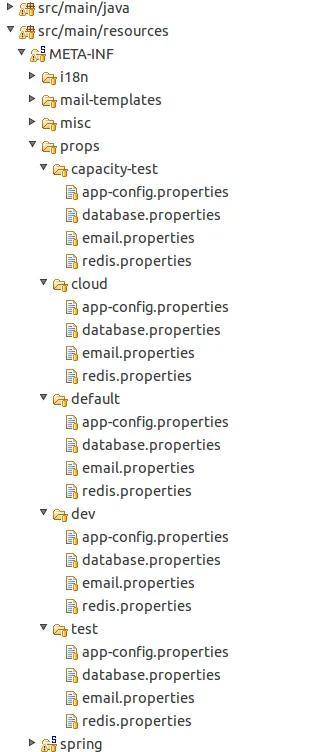我正在开发一个Spring应用程序,意识到我的属性管理方式存在问题。我使用Spring环境配置文件来加载属性,最近添加了更多配置文件使得我的属性文件变得难以管理。
这些属性文件位于src/main/resources/META-INF/props/下的不同文件夹中,每个文件夹对应不同的Spring环境配置文件。
现在我至少有5个配置文件,这意味着我有5个子文件夹,每个子文件夹包含相同名称但仅对某些键具有不同值的属性文件。
这是它的样子:

这是我如何配置我的PropertyPlaceholders:
@Configuration
public class PropertyPlaceholderConfiguration {
@Profile(Profiles.CLOUD)
static class cloudConfiguration {
@Bean
public static PropertySourcesPlaceholderConfigurer propertySourcesPlaceholderConfigurer() throws IOException {
PropertySourcesPlaceholderConfigurer propertySourcesPlaceholderConfigurer = new PropertySourcesPlaceholderConfigurer();
propertySourcesPlaceholderConfigurer.setIgnoreUnresolvablePlaceholders(Boolean.TRUE);
propertySourcesPlaceholderConfigurer.setLocations(new PathMatchingResourcePatternResolver().getResources("classpath*:META-INF/props/cloud/*.properties"));
return propertySourcesPlaceholderConfigurer;
}
}
@Profile(Profiles.DEFAULT)
static class defaultConfiguration {
@Bean
public static PropertySourcesPlaceholderConfigurer propertySourcesPlaceholderConfigurer() throws IOException {
PropertySourcesPlaceholderConfigurer propertySourcesPlaceholderConfigurer = new PropertySourcesPlaceholderConfigurer();
propertySourcesPlaceholderConfigurer.setIgnoreUnresolvablePlaceholders(Boolean.TRUE);
propertySourcesPlaceholderConfigurer.setLocations(new PathMatchingResourcePatternResolver().getResources("classpath*:META-INF/props/default/*.properties"));
return propertySourcesPlaceholderConfigurer;
}
}
@Profile(Profiles.TEST)
static class testConfiguration {
@Bean
public static PropertySourcesPlaceholderConfigurer propertySourcesPlaceholderConfigurer() throws IOException {
PropertySourcesPlaceholderConfigurer propertySourcesPlaceholderConfigurer = new PropertySourcesPlaceholderConfigurer();
propertySourcesPlaceholderConfigurer.setIgnoreUnresolvablePlaceholders(Boolean.TRUE);
propertySourcesPlaceholderConfigurer.setLocations(new PathMatchingResourcePatternResolver().getResources("classpath*:META-INF/props/test/*.properties"));
return propertySourcesPlaceholderConfigurer;
}
}
@Profile(Profiles.DEV)
static class devConfiguration {
@Bean
public static PropertySourcesPlaceholderConfigurer propertySourcesPlaceholderConfigurer() throws IOException {
PropertySourcesPlaceholderConfigurer propertySourcesPlaceholderConfigurer = new PropertySourcesPlaceholderConfigurer();
propertySourcesPlaceholderConfigurer.setIgnoreUnresolvablePlaceholders(Boolean.TRUE);
propertySourcesPlaceholderConfigurer.setLocations(new PathMatchingResourcePatternResolver().getResources("classpath*:META-INF/props/dev/*.properties"));
return propertySourcesPlaceholderConfigurer;
}
...
}
总之,我的问题如下:
- 由于只有少量值不同,所以在5个不同的文件夹中到处都是键/值对的重复。
因此,我正在寻找一种新的策略来管理不同环境之间的差异。
有人能帮忙吗?